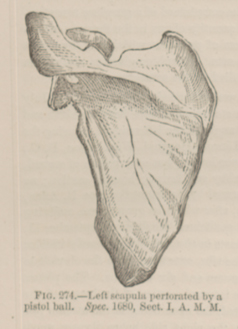Title: C——, Samuel A.
Source text: Surgeon General Joseph K. Barnes, United States Army, The Medical and Surgical History of the War of the Rebellion. (1861–65.), Part 1, Volume 2 (Washington, D.C.: Government Printing Office, 1870), 575-576.
Civil War Washington ID: med.d1e20164
TEI/XML: med.d1e20164.xml
CASE 14.—Corporal Samuel A. C——, Co. E, 1st United States Cavalry, aged 20 years, was wounded in a cavalry charge near Culpeper, Virginia, August 1st, 1863; the missile, a revolver ball, entered the back, left side, about two and a half inches below the spine of the scapula, above the posterior margin of the arm-pit, by the teres muscles, and was found beneath the skin to the right of the sternum, beneath the fourth and fifth ribs. He rode about a mile and then fainted. The hæmorrhage was considerable and he also vomited a little. Cold applications were applied and the patient was conveyed to Washington, entering Douglas Hospital on the next day. On admission, there was extensive emphysema and distressing dyspnœa, the patient breathing with a peculiar puff of the mouth at every expiration. He complained of pain in the left hypochondriac region, in the vicinity of the ball, which was immediately extracted by a perpendicular incision an inch in length. The wound of incision for the exit of the ball immediately gave rise to traumatic dyspnœa until it was closed with straps of isinglass plaster covered with collodion. The patient stated that he had considerable hæmoptysis, perhaps a cup half full, immediately after having been wounded. Small doses of antimony and calomel, with stimulants, were administered, and an anodyne given at night. August 3d: Vomiting; bowels costive. A grain of calomel was given, which opened the bowels. Dyspnœa considerably diminished, but still annoying; pain in left hypochondriac region during cough was allayed by the application of a mustard poultice; emphysema the same as on the day before. August 4th: Appetite good; patient somewhat more comfortable. On the 5th, the anterior wound was opened, which seemed to ease his respiration for a short time, but the distress in breathing soon returned. The patient recognized the extent of his injury and had no hopes of recovery. August 6th: The patient passed a tolerably good night; dyspnœa increased during the course of the day; emphysema in lumbar region; a mild cathartic was given; the cough became more troublesome and painful. The patient vomited a bilious green fluid, and during that act a "paracentesis naturalis" occurred by the violent explosion of the adhesive plaster from the anterior wound, followed by the discharge of a pint and a half of bloody serum and hot blood, which escaped particularly rapidly at each expiration and effort to cough. This escape of the bloody effusion in the thoracic cavity relieved him from the annoying dyspnœa, but weakened him in a great degree. Stimulants were administered freely, but he gradually sank; the arterialization of the blood could not take place; the blood became poisoned by carbonic acid, and he died of coma at 11 o'clock P. M., August 9th, 1863. A post-mortem examination was made ten hours after death. A strong, well-built, robust cadaver; excellent physique. Stiffness of death well marked. Emphysema all about the upper portion of the sternum and both sides of the chest. The back and left thigh were of a mulberry hue. The pistol ball had perforated the inferior edge of the shoulder-blade, just below the glenoid cavity and the infraspinatus and subscapularis muscles. It went into the left thoracic cavity, between the second and third ribs, and penetrated the anterior portion of the upper lobe of the left lung, and, extending across the chest above the blood vessels, entered the lower portion of the upper lobe of the right lung. A perpendicular incision one and a half inches obliquely upward from the right nipple, between the third and fourth ribs, an inch external to the sternum, represented the wound of exit. On removing the isinglass plaster which closed this wound, a considerable rush of air escaped. On careful dissection of the skin, the cervical, pectoral, and abdominal muscles were found largely infiltrated with blood, and there were clots of coagulated blood between the cellular tissues. The right lung was completely collapsed, caused by one-half gallon of blood in the pleural sac; nearly the same condition on the left side. Adhesion of both lungs to costal parietes indicated late pleurisy and the cause of former pain in that region. The heart and its appendages were normal. Paracentesis thoracis was performed between the eighth and ninth ribs on the right side, posteriorly, without injuring the lungs, and it gave exit to the enormous quantity of extravasated blood. The case is reported by Acting Assistant Surgeon Carlos Carvallo. The specimen, numbered 1680 in the surgical series of the Museum, is the left scapula, grooved just below the glenoid cavity. A fissure of one inch and a half, not connected with the direct wound of the ball, exists in the lower wing of the bone. The preparation and the notes of the case were contributed by Assistant Surgeon Wm. Thomson, U. S. A.
